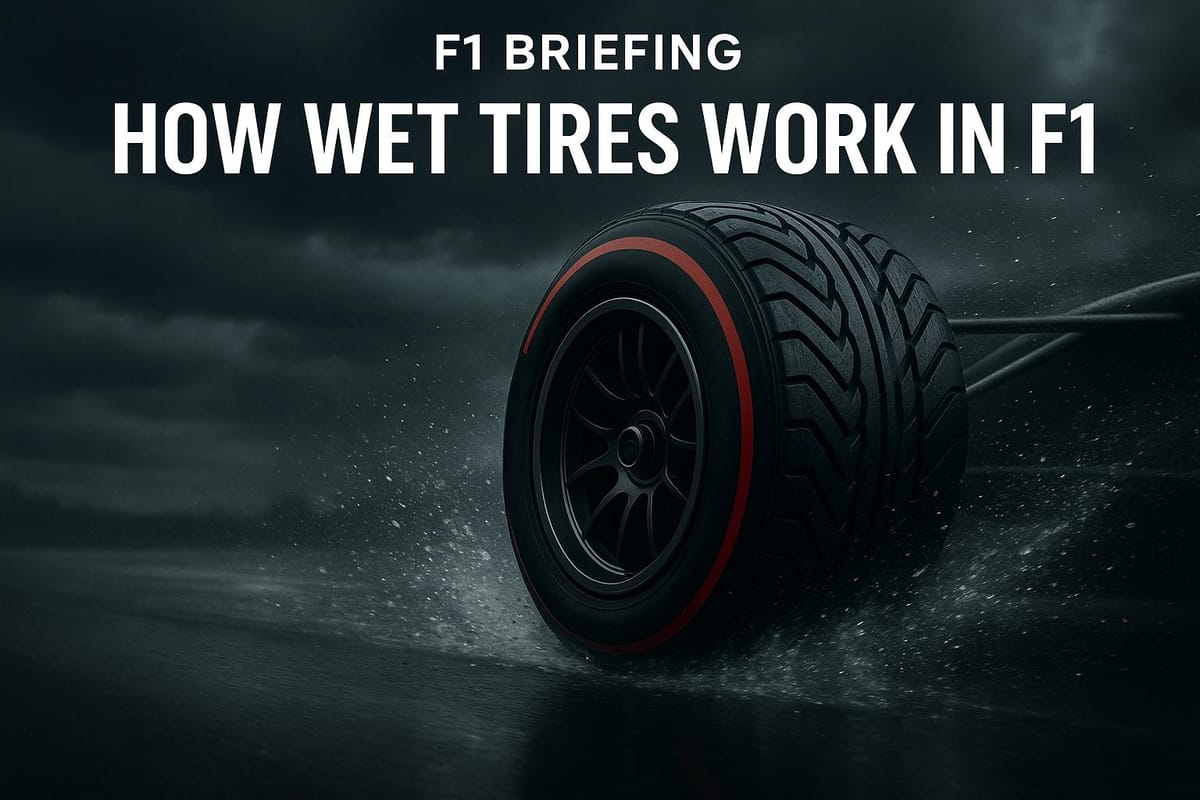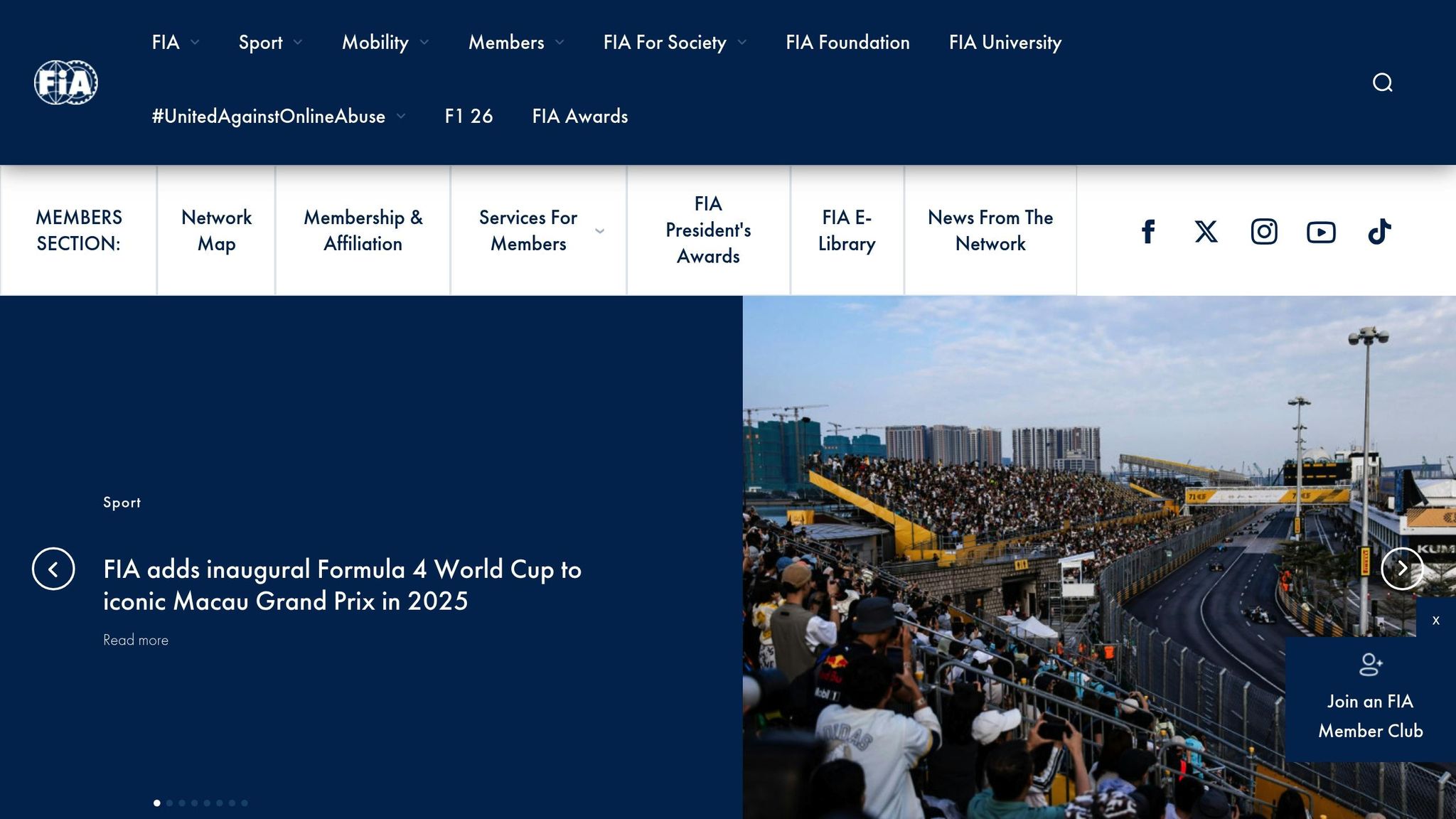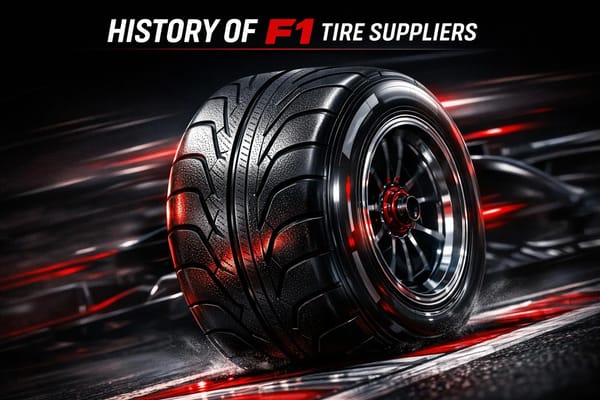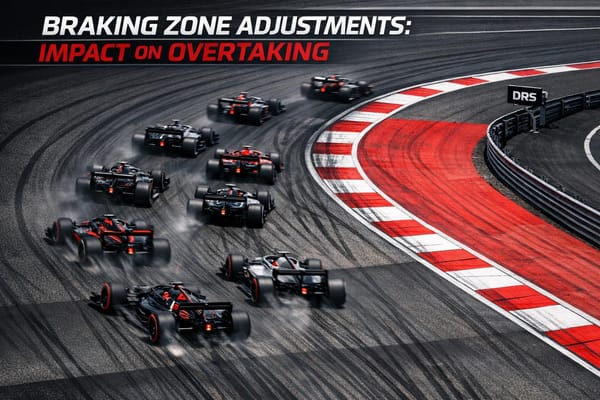How Wet Tires Work in F1
Explore the engineering behind F1 wet tires, their performance in rain, and how teams strategize tire changes during races.

Wet tires in Formula 1 are specially designed to keep cars safe and fast in rainy conditions. Here's what you need to know:
-
Two Types of Wet Tires:
- Full Wet (Blue): Best for heavy rain and standing water, evacuates 85 liters of water per second at 300 kph.
- Intermediate (Green): Ideal for damp tracks and light rain, clears 30 liters per second.
-
Key Features:
- Tread Design: Channels water away to prevent aquaplaning.
- Rubber Compounds: Stay flexible in cold, wet conditions.
- Wider Tires: Improve grip but create more spray, reducing visibility for following drivers.
- Race Strategy: Teams carefully monitor weather and track conditions to decide when to switch between wet, intermediate, and dry tires. Timing is critical to maintain grip and avoid losing track position.
Formula 1 continues to innovate with advanced wet tire designs, ensuring both safety and performance during unpredictable weather.
How F1 Wet Tires Are Made
Water-Clearing Tread Design
F1 wet tires are built with tread patterns specifically designed to channel water away from the tire's contact patch. This reduces the risk of aquaplaning, even in the most challenging wet conditions. The grooves and channels in the tread work together to push water out from under the tire. This water-clearing ability is achieved through precise molding processes that embed the tread pattern directly onto the tire surface. For details on water evacuation rates, refer to the table above.
Rubber Compounds for Wet Weather
The rubber compounds used in wet F1 tires are quite different from those in slick tires. Slicks need high temperatures to deliver optimal grip, but wet tire compounds are engineered to maintain performance at much lower temperatures. This ensures the rubber stays flexible, providing traction on cold and wet surfaces without requiring the intense heat typically needed for dry-weather tires.
Pirelli has developed specific compounds tailored to each type of wet tire:
| Tire Type | Compound Characteristics | Operating Conditions |
|---|---|---|
| Full Wet (Blue) | Maximizes water displacement and offers superior grip in cold conditions | Heavy rain, standing water |
| Intermediate (Green) | Designed for versatility across a wider temperature range | Damp surfaces, light rain |
These compounds are carefully formulated to ensure reliability and grip in varying wet weather scenarios.
Dimensions Designed for Wet Conditions
F1 wet tires are slightly wider than their dry counterparts, which helps improve both grip and water displacement. Full wet tires also have a slightly larger diameter - around 10 mm more than slicks - to further enhance their ability to clear water while maintaining consistent handling. This combination of wider profiles and advanced tread patterns ensures performance is maintained even in unpredictable wet conditions. However, the increased width also leads to more spray, which can reduce visibility for drivers following closely behind.
How Wet Tires Perform
Grip Mechanics on Wet Tracks
F1 wet tires are designed to maintain grip by efficiently channeling water away from the tire surface. This ability varies between full wet and intermediate tires, each tailored for specific wet conditions (check the table above for water evacuation rates). Their unique design enables them to tackle the challenges posed by wet tracks effectively.
Under the 2022 technical regulations, wet tires face an additional challenge: increased upward airflow. This airflow pushes water through the car's diffuser, creating a "water curtain" behind the car. While this helps clear water, it can significantly reduce visibility for drivers following behind. Unlike slick tires, which rely on high temperatures for optimal performance, wet tires are engineered to provide traction in cooler, rainy conditions, ensuring drivers can maintain control even when the weather takes a turn.
Tire Life and Degradation
Tire longevity is another critical factor in wet-weather racing. How well a tire performs over time can directly impact race results, especially in unpredictable conditions. Modern wet tire designs not only influence wear rates but also affect spray patterns, which can hinder visibility during close racing.
A great example of tire management's importance is the 2020 Turkish Grand Prix. Drivers who effectively handled intermediates as the track dried gained a significant advantage.
Recent advancements have further improved wet tire performance. Intermediate tires now feature a newly developed compound that widens their operating range. This allows for a smoother transition between full wet tires and slicks, giving teams better control over tire life while maintaining competitive speeds as track conditions change.
Race Strategy with Wet Tires
When to Switch Tire Types
Choosing the right moment to switch between full wet, intermediate, and dry tires is a game of precision. Teams rely on real-time assessments of track conditions and weather changes. The amount of standing water and the intensity of rainfall are critical factors in this decision. Here’s a quick guide to the water dispersal capabilities of each tire type at speeds of 300 kph:
| Track Condition | Recommended Tire | Key Performance Indicator |
|---|---|---|
| Heavy Rain & Standing Water | Full Wet (Blue) | 85 L/sec water dispersal |
| Damp or Light Rain | Intermediate (Green) | 30 L/sec water dispersal |
| Drying Track | Intermediate → Slick | Based on crossover point |
The crossover point - when one tire type starts outperforming another - is determined by analyzing lap times and feedback from drivers in real time. Teams also keep a close eye on sector times to find the perfect moment for a tire change. Switch too soon, and you risk losing grip. Wait too long, and you might give up valuable track position. This delicate balance highlights the importance of timing, which is heavily influenced by weather monitoring.
Weather Tracking and Pit Timing
F1 teams rely on cutting-edge weather radar, real-time data streams, and trackside observations to stay ahead of weather changes. This allows strategists to predict when rain will begin or end, helping them schedule pit stops to minimize time loss while ensuring the car maintains optimal grip on the track.
FIA Wet Weather Rules

To ensure safety and fair play, the FIA has established strict rules for using wet and intermediate tires. Here are the main points:
- Wet Race Declaration: When a race is officially declared "wet", teams are allowed to skip the usual rule requiring the use of two different dry compounds.
- Mandatory Wet Tires: Race control can mandate the use of wet tires if they determine that slicks are unsafe for the conditions.
- Tire Allocation: Teams have a set limit on the number of wet and intermediate tire sets they can use during a race weekend.
The wider tire design in modern F1 cars has increased water spray, which can reduce visibility significantly. This added challenge often plays a role in shaping pit stop strategies and timing decisions.
How do Wet Tyres work?
New Wet Tire Technology
Advancements in wet tire technology continue to refine grip and water management, building on the foundation of earlier designs.
Multi-Condition Tires
Pirelli has introduced multi-condition wet tires designed to handle a variety of track conditions. The newest intermediate tire compounds expand the performance range, giving drivers greater control during the tricky transitions between wet and dry conditions - without requiring immediate pit stops.
Here’s how the new technology stacks up against traditional wet tire designs:
| Track Condition | Traditional Design | New Technology |
|---|---|---|
| Drying Track | Limited effectiveness | Extended performance window |
| Mixed Conditions | Required early switch | Maintains grip longer |
| Temperature Range | Narrow operating window | Broader working range |
This expanded capability paves the way for even more advancements in water management.
Improved Water Management
Modern F1 cars kick up significant spray due to their wider tires. To tackle this, the FIA and Pirelli are testing innovative solutions, including a prototype wheel arch designed to reduce spray at its source. This prototype is set for testing at Silverstone after the British Grand Prix.
The latest tire designs focus on better water evacuation by incorporating:
- Enhanced tread patterns and optimized compounds that work seamlessly with modern aerodynamics to minimize spray.
- Increased resistance to aquaplaning, ensuring safer handling in heavy rain.
- Improved grip across a wider range of temperatures and moisture levels.
These advancements are the result of close collaboration between F1 teams and Pirelli, ensuring the new designs meet the demands of high-performance racing.
Conclusion
Wet tires play a crucial role in Formula 1, striking a delicate balance between ensuring safety and maintaining the thrill of competition during unpredictable weather. Their advanced engineering and performance capabilities are pivotal to the sport, even as new challenges emerge.
The 2022 technical regulations have added layers of complexity, with modern car designs creating more spray that hampers driver visibility in wet conditions. These changes have required adjustments in both tire development and race strategies. The combination of intermediate and full wet tires provides teams with strategic options tailored to varying levels of rainfall.
F1 continues to push boundaries in wet weather performance. For instance, the FIA's ongoing exploration of solutions like wheel arch designs highlights the sport's dedication to practical improvements. This relentless pursuit of better wet tire technology showcases Formula 1's commitment to keeping drivers safe while delivering high-performance racing, no matter the weather.
FAQs
When do F1 teams switch between full wet and intermediate tires during a race?
F1 teams make the call to switch between full wet tires and intermediate tires by analyzing a mix of track conditions, weather forecasts, and tire performance metrics. Full wet tires are built to handle heavy rain, with deep grooves that efficiently push water away, reducing the risk of hydroplaning. In contrast, intermediate tires are better suited for lighter rain or damp tracks, providing improved grip and lasting longer as the surface begins to dry.
To nail this decision, teams depend on real-time weather updates, feedback from drivers, and data collected from car sensors. Getting the timing right is crucial - sticking with the wrong tires for too long can slow lap times or cause tires to wear out faster, both of which can have a big impact on race results.
How have advancements in wet tire technology enhanced performance and safety in Formula 1?
In Formula 1, wet tire technology has come a long way, transforming how cars perform and stay safe in tough weather conditions. These tires are crafted with deep grooves and unique tread patterns that push water away from the tire's contact area. This design helps prevent hydroplaning, allowing cars to maintain grip even on slippery, rain-soaked tracks.
The magic doesn’t stop there. The rubber compounds in wet tires are specially made to stay soft and flexible, even when temperatures drop. This flexibility gives drivers the traction they need to navigate cold, rainy conditions with confidence. These advancements not only help drivers keep control at high speeds but also reduce the risk of accidents, proving just how vital wet tires are for both safety and performance in F1.
How do F1 wet tires prevent hydroplaning and maintain grip on wet tracks?
When it comes to F1 wet tires, their design is all about handling rain-soaked tracks. They feature deep grooves and distinct tread patterns that work to channel water away from the tire's contact area. This reduces the risk of hydroplaning and helps the tires stay firmly connected to the track, even during heavy downpours.
What sets wet tires apart even further is the rubber compound. It's softer and more flexible than what you'd find in dry tires, which means it grips slippery surfaces much better. By combining these unique tread designs with specialized materials, wet tires give drivers the control and performance they need to tackle tough, rainy conditions.




